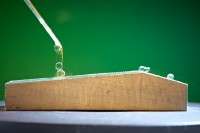Leidenfrost thermostat uses levitating water droplets to keep cool

The Leidenfrost effect is a strange phenomenon that allows water droplets to levitate and even climb uphill. Now physicists at the University of Bath have harnessed this quirk of physics to create a thermostat with no moving parts.
When droplets of water on a heated surface reach a certain temperature, the droplet surface starts to boil rapidly making it float or levitate on the evaporated gas vapour. This is known as the Leidenfrost effect and is commonly seen during cooking – when sprinkling water onto a hot pan which is above the Leidenfrost temperature point, droplets skitter across the pan and take longer to evaporate.
The team at Bath previously found that they could make water droplets travel in different directions on a ratcheted heated surface by changing the temperature and texture of the surface. They also found that droplets can even be made to climb uphill – the sharper the teeth of the surface, the steeper incline they were able to climb.
The scientists have used these findings to develop a thermostat with no moving parts. Thermostats maintain the temperature of a system at a constant level by switching on a heater when it is too cold, and switching it off again when it has reached the correct temperature.
The Leidenfrost thermostat works by using the cooling power of water droplets. It moves the water droplets in one direction to cool the system when the temperature is too high, but discards the drops by moving them in the opposite direction when the temperature is too low, allowing the system to heat up to the correct temperature.
Published in the Journal of Heat Transfer, the thermostat is demonstrated in a short film made by undergraduate students:
Dr Kei Takashina, Academic Fellow in the University's Department of Physics, explained: "The Leidenfrost effect has traditionally been viewed as a problem in the world of heat transfer systems, but we've harnessed this phenomenon to make a thermostat.
"This thermostat has no moving parts, and unlike conventional thermostats it doesn't rely on an electrical source to work.
"This is the first time we've demonstrated negative feedback using the Leidenfrost effect. Our proof-of-principle device demonstrates that temperature can be controlled and stabilised using the Leidenfrost effect, but as it has no mechanical moving parts except for the water, it could potentially be more reliable than other thermostats."
The researchers demonstrated the Leidenfrost effect in 2013 to millions of viewers across the world by creating the "Leidenfrost maze", which became a viral film on YouTube and several popular science websites. It was even shown by Stephen Fry on the BBC game show QI.
The researchers are now aiming to scale up the thermostat and investigate the range of temperatures at which it will work.
More information: "A Leidenfrost Thermostat." J. Heat Transfer 137(3), 034502 (Mar 01, 2015) (5 pages) DOI: 10.1115/1.4029238
Provided by University of Bath




















